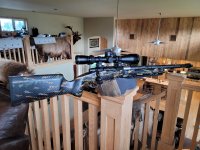You are correct, capped turrets all around would serve me just fine. But so would Razor G2 4.5-27-level effort pop up turrets. Or a lever lock like on new S&B or March turrets. Or the Leupold Mark 5 turrets.It sounds like you want to buy a scope with a capped elevation turret to be honest. I train because what happens when your locked down turret STILL moved and you didn't catch it because you assumed it was solid? Been there, done that. Thank god it was at a stupid gopher and not a trophy bighorn. If you have buck fever to the point of consciously needing to think about chambering a round, you should be training more anyways.
And for the record: If a turret as a lock on it, I want it to require some effort. I think the LHT's lock looks too light. I just don't think you should be relying on that lock regardless of what optic.
And I just want to make sure that nobody thinks my little hunting novella above reflects my experiences. I’ve never hunted like that.
But, I design things for people to use, and as a designer you have to empathize with a typical person's problems (current and potential) if a successful product is the end goal (unless you’re designing Windows in the 1990s, lol).
You want to make a person’s life better, not worse.
It’s really easy to reflexively blame the user, and it’s easy for the user to simply blame themselves. Entire books have been written this upon subject in the design literature.
It turns out that both “blame user” and “user self-blame” usually stem from a poorly designed product/product feature/system.
Not always, however, as there’s always that clod that adjusts his turrets with vice-grips and slathers everything with anti-seize. <shudder>
Last edited:



